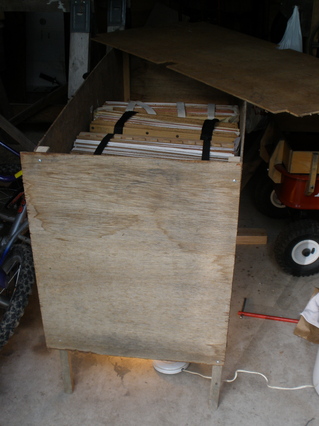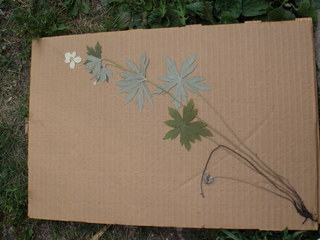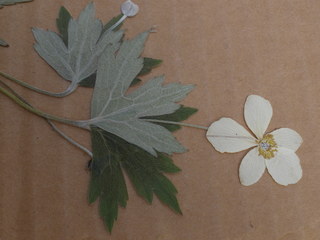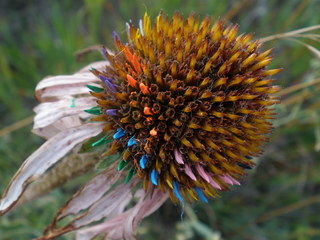|
|
DATA
Here is a copy of my excel file with all my data. The sheet labeled corrected data for analysis is the file with all the data for each treatment. The sheet labeled baggins has a list of all the heads I used that need to be harvested, this was also posted in a separate post called “Baggins.” The ones labeled “donor” do not need to be harvested but should not be expected to have high seed set as they were bagged for most of their flowering time.
Pollination interference data (data entry 2).xls
HARVESTING
I need all of the heads used in my project (the ones that are painted) to be harvested in egg cartons (located in the shelf above the sink in the Hjelm house). Please label the compartment of the egg carton with the row, pos and tt color of the head. The egg cartons should be packed so that they wont be disturbed during travel and please be careful with the heads so no seeds fall out! Gretel has a list of all the heads to be harvested and its posted on the flog in July (“Baggins”). Please mail the packaged heads to: 119 School Street, Keene, NH 03431
LANDFILL SPECIES
I have been collecting plants at Landfill this season and have started to compile a list of the plants I have either seen or collected there. If Megan and anyone else would like to add plants to that list that would be great! Or check my identification. This list is very rough at the moment but I will continue to update it as I get more plants identified.
Species list landfill 2009.xls
Here is a file with the pollen storage data (excluding Stuart’s data on the 48 hour style persistence).
pollen storage data sheet.xls
We pollinated 3 plants in the common garden that were still flowering. Each plant had 3 treatments of stored Echinacea pollen; ambient temperature, frozen, and refrigerated. The frozen and refrigerated pollen caused shriveling, the ambient temperature treatment did not.
Here is my dataset that I am working on analyzing in R as a .csv file.
halverson.data.091.csv
Stuart, here is my R script so far:
halverson.data.analysis1.R
I made new columns in the .csv spreadsheet for the factors and levels we discussed. I will work on a list of hypotheses to test. I think I changed the definition of “y” when I did my 24 hour analysis. Can I give “y” a different name for each analysis? Or does the code need to read a defined “y” each time?
Thanks for the help and check out the graph of 24 hours and the summary m2.
Allegra
I went on a fantastic bike ride yesterday and saw a large prairie restoration on the east side of county road 7 between Moe Hall Rd SW and Tower Hill Rd SW. I also saw a population of Ratibida and Desmodium on the west side of County Rd 15 between MN-27 and Tower Hill Rd SW. Sorry I couldn’t be more specific with my directions but if you bike or drive those sections of road you will definitely find the spots.
Here’s a photo of the box I built for drying plants with generously donated materials from the Wagenius family.

A pressed specimen of Anemone canadensis collected at Hegg Lake with Greg.


One of my painted heads after being repainted this week. Each paint color identifies a pollen treatment.

Thanks to Mimi for letting me use her camera!
Here is a list of the plants I used in the common garden for my experiment on pollen interference/competition. I used 20 randomly selected plants in the 96 garden with 12 pollination treatments on each plant. The heads I harvested are also included in this spreadsheet, but here they are again: 39 952 blu and wht heads were harvested on 7/24/09.
Baggins.CG.09.xls
The preliminary results seem to show that the only treatments that consistently did not shrivel were:
silver-the control, no pollinations
white-Carduus acanthoides pollen only (thistle)
pink-Coreopsis palmata pollen only
All of the treatments that received echinacea pollen (either am or pm) showed somewhat consistent shriveling…. will it hold up to the stats…. we will see!
the most interesting treatment is…..
purple-Heliopsis helianthoides pollen only- this one had a mix of results, which may be due to differences in the amount of pollen arriving on the styles or some other factor. but it certainly did not show consistent style persistence. hmmmmm…..
Just as a reminder, style shriveling indicates that compatible Echinacea pollen has arrived on a style, and can be a good predictor of seed set. Style persistence indicates that compatible pollen has not landed on a style. In the case of some of my treatments which had both Echinacea pollen and another type of pollen, shriveling may not indicate seed set. This will be tested by dissecting the heads and weighing the seeds later this year.
More results to come soon…
Greg and I have been collecting plants and pressing them. I am doing a plant collection with plants mainly from landfill for one of my classes next year at McGill in Plant Systematics. Greg is collecting specimens of anything that co-flowers with Echinacea and making slides with the pollen from each specimen to compare with the pollen found on the pollinators and styles from pollinator competition experiments. Greg, here is a site with information on collecting plants from the Missouri Botanic Gardens
Here is a document from my class that also describes field collection techniques:
HELPFUL HINTS2010.doc
I also made a drying box for the pressed plants, which is almost finished…
Stuart, here are the estimates of people hours I will need for my project. Also, a schedule of times when I would need helpers during this week. Who wants to trade some hours?
Monday I would ideally like to paint and count styles for up to 80 treatments which I estimate will take 9-10 people hours (depending on how many need to be trained). I would like to do it after phenology or at least do the style persistence before lunch, painting can happen later. Wednesday and Thursday also follow the same schedule.
But… this would mean a big pollination day on Tuesday, when everyone is out in the remnants. Pollination takes about the same amount of time. So Mimi and I have come up with several possible solutions (or a combination):
– If Ruth will be here Tues. morning she could help collecting insects and someone else could help pollinate
– Cut the remnants down to 9 instead of 10
– Have some people in smaller remnants leave a little earlier than 11am, or have vehicles and be able to book it back at 11 to help pollinate from 11-12
– Cut down the treatments painted on Monday, however I don’t want to cut down too much, since some of my plants have been flowering since Thursday or Friday and I don’t want to wait too long
– Skip painting on Monday, paint Tuesday and Thursday, and pollinate Wed. and Friday when we have more people to spare
– I would also like help collecting pollen on Tues. and Wed. but I may be able to do this myself if needed.
– lastly, I need one person to help me do afternoon pollination on Tuesday and Thursday between 2-4pm
Sorry for throwing this into the mix so late in the game folks. I guess it was just hard to know how many hours and people I would need before we did a full day of painting and pollinating.
-Allegra
My project is almost ready to start this week!
I will be hand pollinating heads on 20 flowering plants in the ’96 section of the CG with different species of foreign pollen and Echinacea pollen to simulate pollen loads arriving from generalist pollinators. The Echinacea pollen will be applied at the same time as the foreign pollen, 4 hours after, or not at all depending on the treatment. I should start painting bracts for the first flowers in the next couple of days. After discussing the pros and cons of different pollinator exclusion methods, I have decided I will use bags for the 20 plants in my study, and cages for the plants I will be taking pollen from frequently. All my plants now have blue flags in the CG. Ruth brought new paint for us to use, including a lovely new dark purple color. Thanks Ruth!
I have also decided to use 3 different foreign pollen donors and no mixes for my treatments. After some practicing collecting pollen from different species at the Landfill, here are the best species I have come up with that have easy to collect pollen:
Lead plant-Amorpha canescens-Fabaceae
False sunflower-Heliopsis helianthoides-Asteraceae
These are both common in the remnants and co-flower with Echinacea, hopefully sharing pollinators.
Other possibilities:
Coreopsis palmata-Asteraceae
Thistle-whichever is in flower?-Asteraceae
Prairie anemone-Anomone sp.-Ranunculaceae
Also, the bike gang is now 7 deep, so K-town betta watchout!
Allegra
Calling all Veggie Lovers! Anyone interested in a CSA basket? I’ll call this farm tomorrow to see if they will give us a partial summer share for the weeks we are here. They deliver to Alexandria on Thursdays.
Ploughshare Farm
(218) 267-5117
http://www.ploughsharefarm.com
Also, Alexandria Farmers’ Market
Tues & Sat 9 – noon & Thursday 3 – 6 pm.
(320) 763-6893
http://www.mfma.org
Located in Big Ole Central Park at Broadway and 2nd Ave., in Alexandria. Offering a full line of locally raised fruits and vegetables including: apples, beans, beets, blueberries, broccoli, cabbage, carrots, cucumbers, herbs, lettuce, onions, peas, peppers, potatoes, pumpkins, raspberries, squash, strawberries, sweet corn, tomatoes, bedding plants, flowers, elk, lamb, beef and chickens. New location, South of Agnes Lake on the Central Lakes Trail, 1/2 block north of the Chamber Office/Runestone Museum
And, Berry Ridge Farm
Call for hours, May-Nov. (320) 763-6893
1301 Firemans Lodge Road SW. Located 2 miles west of Alexandria on the east side of Lake Latoka. Blueberries, strawberries, raspberries, tomatoes, beans, peas, cucumbers, pumpkins, squash and more.
Let the jam making begin!
I found these farms and more at http://www3.mda.state.mn.us/mngrown
|
|




